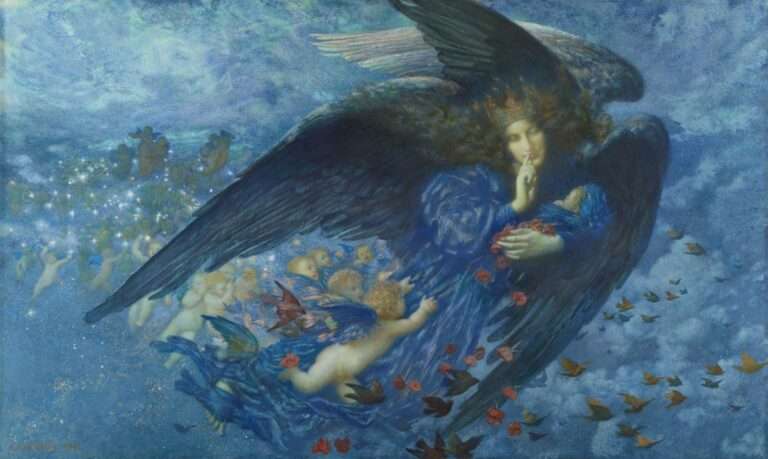The Deeper Meaning Behind Installation Art Symbolism

Installation art is a form of contemporary art that is created in a specific space, often using a combination of different materials and mediums. It is a three-dimensional artwork that is designed to transform the viewer’s perception of the space and create an immersive experience. Installation art can be temporary or permanent, and it often incorporates elements of sculpture, painting, and performance.
The history of installation art can be traced back to the early 20th century, with the emergence of the Dada movement and the Surrealist movement. Artists such as Marcel Duchamp and Salvador Dali were among the pioneers of installation art, using found objects and unconventional materials to create their artworks. Installation art gained further prominence in the 1960s and 1970s with the rise of conceptual art and the Fluxus movement.
Symbolism plays a crucial role in installation art, as it allows artists to convey deeper meanings and messages through their artworks. Symbolism is the use of symbols or images to represent ideas or qualities. It can be used to evoke emotions, provoke thought, or comment on social and political issues. In installation art, symbolism can be found in the choice of materials, the arrangement of objects, the use of color, and even in the interaction between the artwork and the viewer.
The Role of Symbolism in Installation Art
Symbolism is an essential element in installation art, as it allows artists to communicate complex ideas and concepts through visual means. In installation art, symbolism can be used to convey emotions, explore personal experiences, comment on social issues, or challenge traditional notions of art.
One example of installation art with strong symbolism is “The Dinner Party” by Judy Chicago. This monumental artwork consists of a triangular table with place settings for 39 historical and mythical women. Each place setting represents a different woman from history who has made significant contributions to society. The symbolism in this artwork lies in the representation of women’s achievements and the celebration of their accomplishments, which have often been overlooked or marginalized in traditional historical narratives.
Another example of installation art with strong symbolism is “The Weather Project” by Olafur Eliasson. This installation, which was exhibited at the Tate Modern in London, consisted of a large artificial sun that filled the entire Turbine Hall. The symbolism in this artwork lies in the manipulation of light and space to create an immersive environment that evokes a sense of awe and wonder. The artificial sun represents the power of nature and our relationship with the natural world.
The Significance of Space and Environment in Installation Art
The space and environment in which an installation art is created play a crucial role in its overall impact and symbolism. The choice of space can enhance or detract from the intended message of the artwork, and the environment can influence how viewers interact with and perceive the installation.
One example of installation art that utilizes space and environment is “The Gates” by Christo and Jeanne-Claude. This installation consisted of 7,503 saffron-colored fabric panels that were suspended from 16-foot-tall steel frames along 23 miles of pathways in New York City’s Central Park. The symbolism in this artwork lies in the transformation of the park’s landscape and the creation of a temporary, immersive experience for visitors. The choice of Central Park as the location for this installation was significant, as it is a public space that is accessible to people from all walks of life.
Another example of installation art that utilizes space and environment is “The Spiral Jetty” by Robert Smithson. This earthwork sculpture was created in 1970 on the northeastern shore of the Great Salt Lake in Utah. The symbolism in this artwork lies in its remote location and its interaction with the natural environment. The spiral shape of the sculpture mirrors the natural formations found in the surrounding landscape, and its placement in the water creates a sense of harmony between the artwork and its surroundings.
The Use of Found Objects in Installation Art Symbolism
Found objects are everyday objects that are repurposed and incorporated into an artwork. They can be anything from discarded materials to natural objects found in the environment. Found objects are often used in installation art to convey symbolism and evoke a sense of nostalgia or familiarity.
One example of installation art that uses found objects is “The Physical Impossibility of Death in the Mind of Someone Living” by Damien Hirst. This artwork consists of a preserved tiger shark suspended in a tank of formaldehyde. The symbolism in this artwork lies in the juxtaposition of life and death, as well as the exploration of mortality and the fragility of life. The use of a found object, such as the shark, adds an element of realism and provokes a visceral reaction from the viewer.
Another example of installation art that uses found objects is “The Dinner Party” by Judy Chicago, mentioned earlier. In this artwork, Chicago used a variety of materials, including ceramics, textiles, and found objects, to create the place settings for each historical and mythical woman. The use of found objects adds depth and complexity to the artwork, as each object carries its own history and symbolism.
The Importance of Color in Installation Art Symbolism
Color plays a significant role in installation art symbolism, as it can evoke emotions, create visual impact, and convey meaning. Different colors have different associations and can be used to represent specific ideas or concepts.
One example of installation art that uses color symbolism is “The Gates” by Christo and Jeanne-Claude, mentioned earlier. The saffron-colored fabric panels used in this installation were chosen specifically for their symbolic meaning. Saffron is a color associated with spirituality and enlightenment in many cultures, and its use in this artwork represents the transformative power of art and the potential for change.
Another example of installation art that uses color symbolism is “The Weather Project” by Olafur Eliasson, mentioned earlier. The use of warm, golden light in this installation creates a sense of warmth and comfort, while also evoking a sense of awe and wonder. The color yellow is often associated with happiness and positivity, and its use in this artwork reinforces the idea of the artificial sun as a source of light and energy.
The Relationship between Installation Art and Performance Art Symbolism

Performance art is a form of art in which the artist uses their body or actions to convey a message or create an experience. Installation art and performance art are closely related, as both forms of art often involve the use of space, objects, and audience interaction.
One example of installation art that incorporates performance art is “The Artist is Present” by Marina Abramović. This installation consisted of Abramović sitting silently at a table in the atrium of the Museum of Modern Art in New York City for a total of 736 hours over the course of three months. The symbolism in this artwork lies in the artist’s presence and her willingness to engage with the audience on a deeply personal level. The performance aspect of this installation adds an element of vulnerability and intimacy, as viewers are invited to sit across from Abramović and make eye contact with her.
Another example of installation art that incorporates performance art is “The House with the Ocean View” by Marina Abramović. This installation consisted of three small rooms that were elevated on platforms, each containing different objects and materials. Abramović lived in these rooms for 12 days, during which time she performed various actions and rituals. The symbolism in this artwork lies in the exploration of physical and emotional boundaries, as well as the idea of confinement and isolation.
The Role of Audience Participation in Installation Art Symbolism
Audience participation is a key element in installation art symbolism, as it allows viewers to become active participants in the artwork and engage with it on a personal level. Audience participation can take many forms, from physical interaction with the artwork to the sharing of personal stories or experiences.
One example of installation art that involves audience participation is “The Visitors” by Ragnar Kjartansson. This installation consists of nine video screens, each showing a different musician performing the same song in different rooms of a historic mansion. Viewers are invited to walk through the rooms and experience the music from different perspectives. The symbolism in this artwork lies in the collective experience of music and the power of shared emotions. The audience’s participation in this installation adds an element of intimacy and connection, as viewers are able to interact with the musicians and become part of the performance.
Another example of installation art that involves audience participation is “The Obliteration Room” by Yayoi Kusama. This installation consists of a white room filled with furniture and objects that are painted white. Viewers are given colored stickers and invited to place them anywhere in the room. Over time, the room becomes covered in colorful dots, creating a vibrant and immersive environment. The symbolism in this artwork lies in the transformation of space through collective action, as well as the idea of individuality and self-expression.
The Connection between Installation Art and Political/Social Issues Symbolism
Installation art has often been used as a platform for artists to address political and social issues and provoke thought and discussion. Through their artworks, artists can raise awareness about important topics, challenge existing power structures, and give voice to marginalized communities.
One example of installation art that tackles political and social issues is “The Vietnam Veterans Memorial” by Maya Lin. This installation consists of two black granite walls that are inscribed with the names of over 58,000 American soldiers who died during the Vietnam War. The symbolism in this artwork lies in the representation of loss and sacrifice, as well as the healing power of remembrance. The installation serves as a memorial to those who lost their lives in the war and a reminder of the human cost of conflict.
Another example of installation art that tackles political and social issues is “The AIDS Memorial Quilt” by the NAMES Project Foundation. This installation consists of individual panels that are created by friends and family members of those who have died from AIDS-related illnesses. Each panel represents a different person and tells their story through images, words, and symbols. The symbolism in this artwork lies in the celebration of life and the fight against stigma and discrimination. The installation serves as a powerful reminder of the impact of the AIDS epidemic and a call to action for greater compassion and understanding.
The Evolution of Installation Art Symbolism throughout History
Installation art symbolism has evolved significantly throughout history, reflecting changes in society, technology, and artistic practices. In its early stages, installation art was often associated with avant-garde movements such as Dadaism and Surrealism, which sought to challenge traditional notions of art and explore new ways of expression.
One example of installation art from the early 20th century is “Fountain” by Marcel Duchamp. This artwork consisted of a urinal that was signed with the pseudonym “R. Mutt” and submitted to an exhibition organized by the Society of Independent Artists in 1917. The symbolism in this artwork lies in its subversion of traditional artistic conventions and its challenge to the notion of what can be considered art. Duchamp’s use of a found object as an artwork was revolutionary at the time and paved the way for future generations of artists to experiment with unconventional materials and mediums.
Another example of installation art from the mid-20th century is “Homage to New York” by Jean Tinguely. This artwork consisted of a large kinetic sculpture that was designed to self-destruct. The symbolism in this artwork lies in its commentary on the impermanence of art and the destructive nature of progress. Tinguely’s use of movement and sound in this installation created a sense of chaos and unpredictability, reflecting the anxieties and uncertainties of the post-war era.
The Future of Installation Art Symbolism in the Art World
The future of installation art symbolism is likely to be shaped by advancements in technology, changes in societal values, and the continued exploration of new materials and mediums. As artists continue to push the boundaries of what is possible in installation art, we can expect to see more immersive and interactive experiences that challenge our perceptions and provoke thought.
One example of contemporary installation art with strong symbolism is “Rain Room” by Random International. This installation consists of a large room filled with falling water, which is controlled by sensors that detect the presence of viewers. As viewers walk through the room, they are able to navigate through the rain without getting wet. The symbolism in this artwork lies in the exploration of control and power, as well as the relationship between humans and nature. The installation serves as a metaphor for our ability to manipulate and shape our environment, while also highlighting our vulnerability and dependence on natural forces.
Another example of contemporary installation art with strong symbolism is “Infinite Staircase” by Olafur Eliasson. This installation consists of a series of mirrored staircases that create an illusion of infinite space. The symbolism in this artwork lies in its exploration of perception and reality, as well as the idea of infinity and eternity. The installation challenges our understanding of space and time, inviting viewers to question their own existence and place in the universe.
In conclusion, installation art symbolism is a powerful tool that allows artists to convey complex ideas and emotions through visual means. Through their choice of materials, use of space, incorporation of found objects, and exploration of color and performance, artists are able to create immersive and thought-provoking experiences for viewers. Installation art symbolism has evolved significantly throughout history, reflecting changes in society, technology, and artistic practices. As we look to the future, we can expect to see more innovative and interactive installation artworks that challenge our perceptions and push the boundaries of what is possible in art.
If you’re interested in exploring the symbolism behind installation art, you may also find the article on the symbolism of the moon fascinating. The moon has long been associated with various meanings and interpretations, ranging from femininity and intuition to cycles of life and emotions. Understanding the symbolism of the moon can provide valuable insights into the deeper layers of meaning in installation art. To delve into this topic further, check out https://symbolismhub.com/what-does-the-moon-symbolize/.
FAQs
What is installation art?
Installation art is a type of contemporary art that involves creating a three-dimensional environment or immersive experience for the viewer. It often incorporates various materials and media, such as sculpture, video, sound, and performance.
What is the purpose of installation art?
The purpose of installation art is to create a unique and immersive experience for the viewer that goes beyond traditional forms of art. It often aims to challenge the viewer’s perceptions and emotions, and can address social, political, and cultural issues.
What is symbolism in installation art?
Symbolism in installation art refers to the use of objects, images, and other elements to represent abstract ideas or concepts. These symbols can be used to convey a deeper meaning or message within the artwork.
How is symbolism used in installation art?
Symbolism can be used in installation art in a variety of ways, such as through the use of specific colors, objects, or materials. These symbols can be used to represent ideas such as identity, memory, or social issues, and can be interpreted in different ways by the viewer.
What are some examples of installation art with symbolism?
Examples of installation art with symbolism include Yayoi Kusama’s “Infinity Mirror Rooms,” which use mirrors and lights to create an immersive experience that represents the artist’s struggle with mental illness, and Ai Weiwei’s “Sunflower Seeds,” which uses thousands of porcelain sunflower seeds to comment on issues of mass production and consumption in China.





